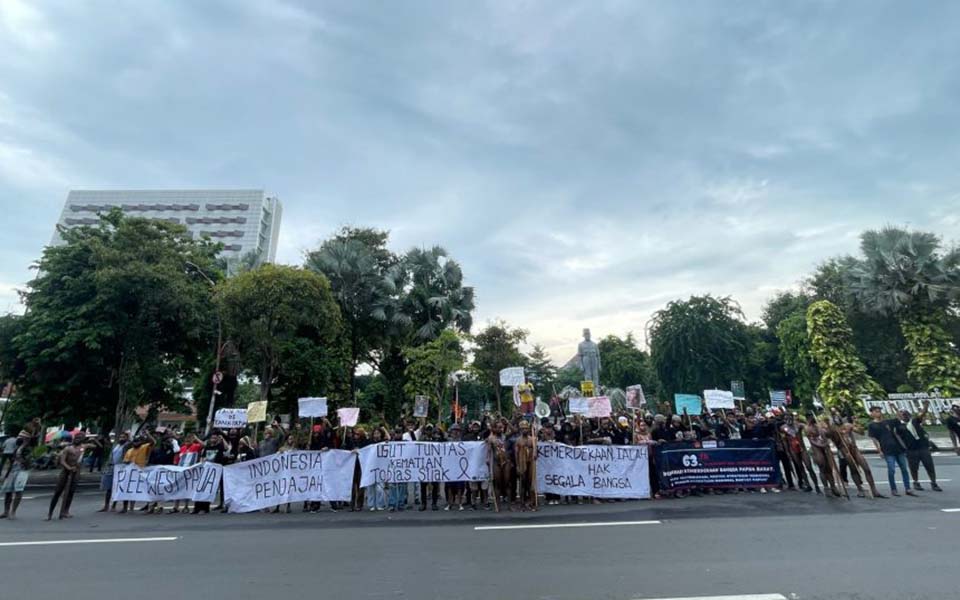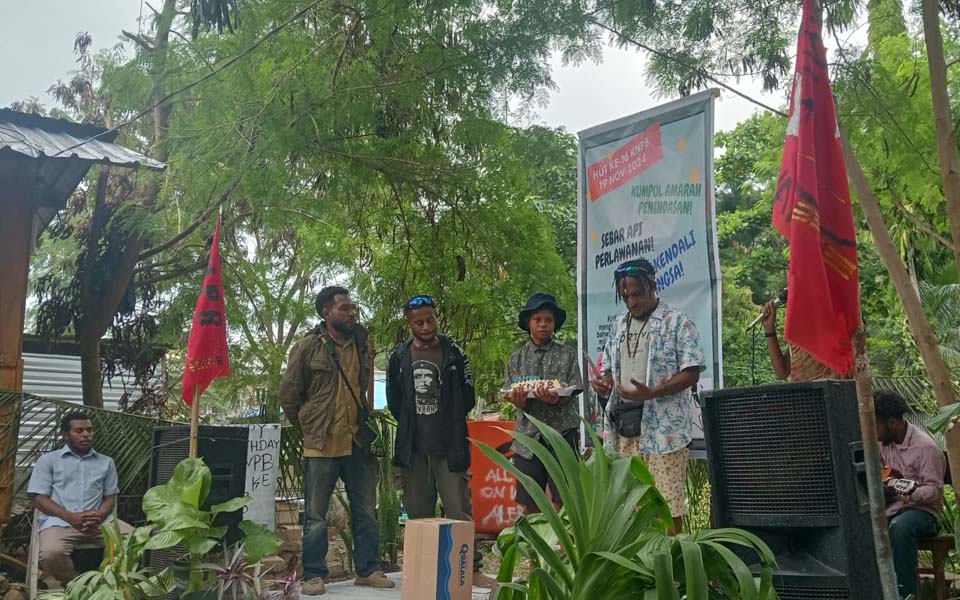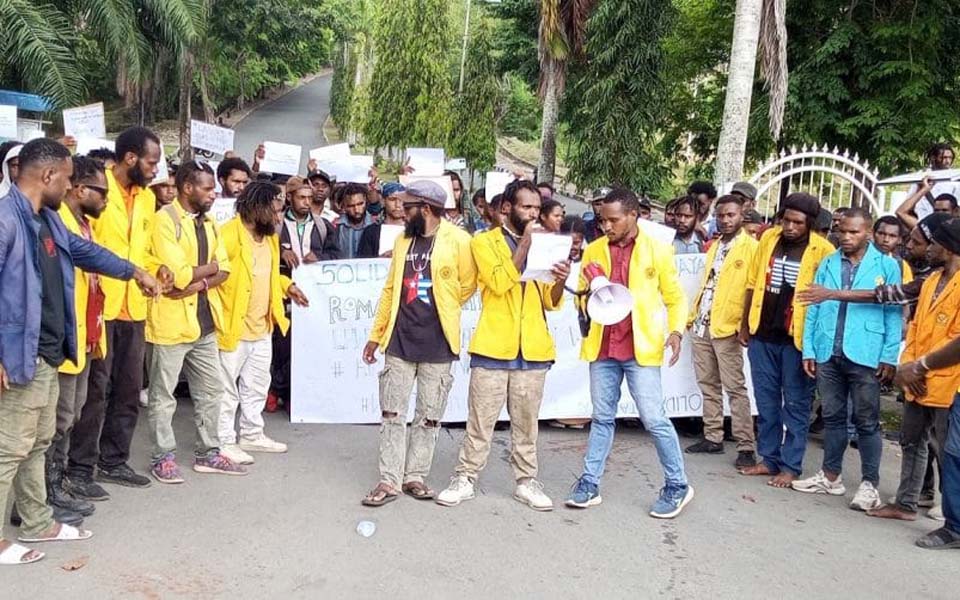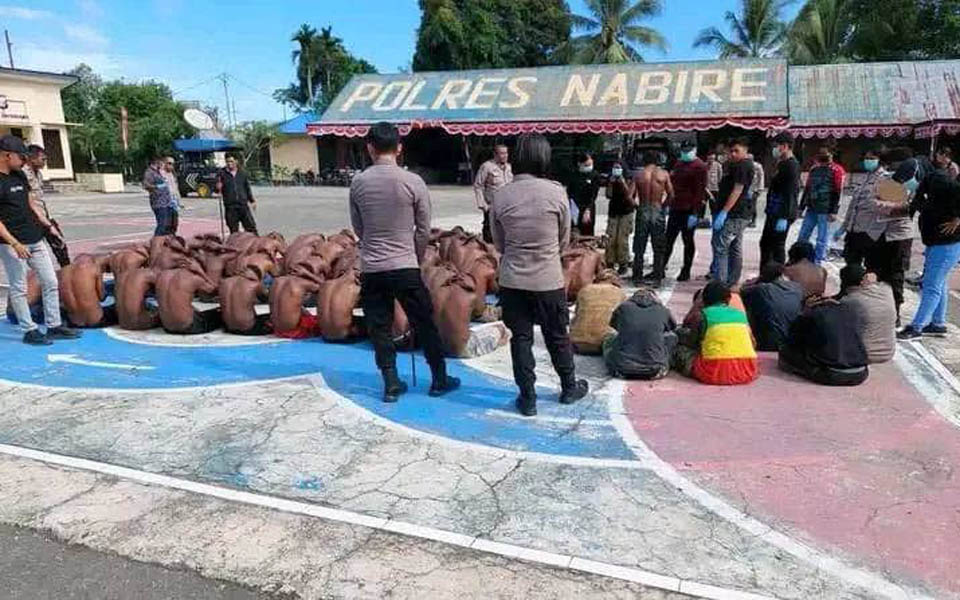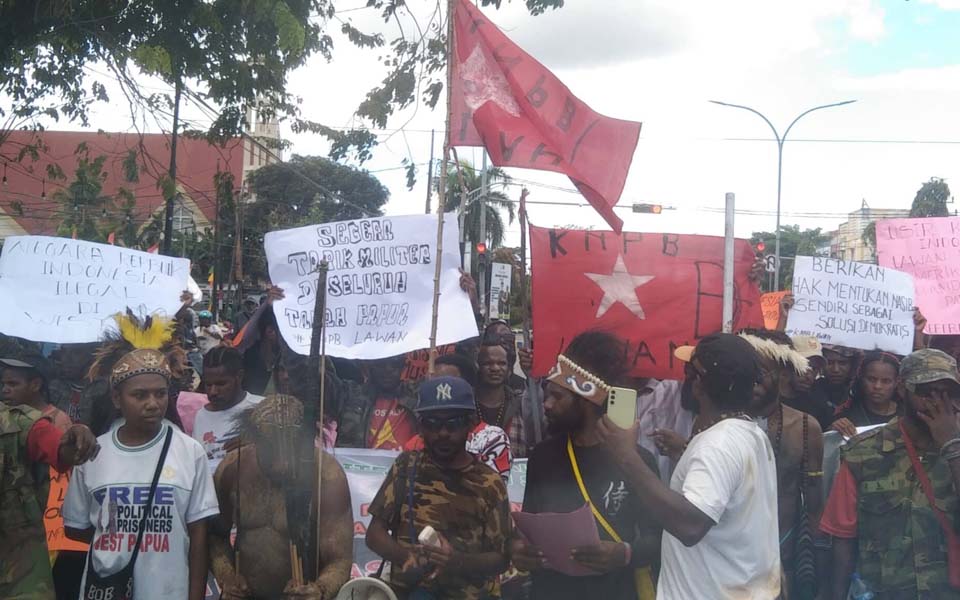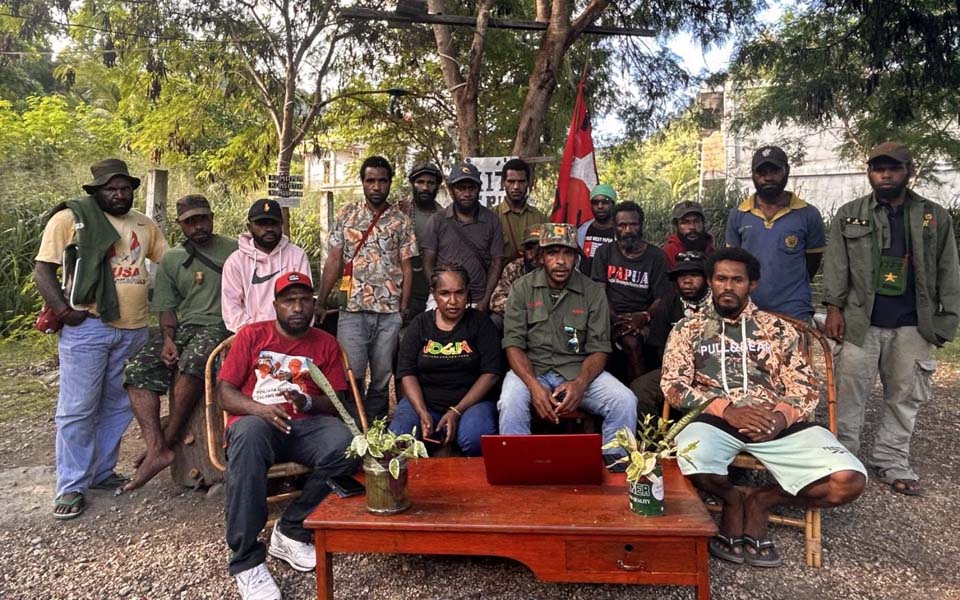Surabaya – Protesters from the Papua Student Alliance (AMP) held a demonstration commemorating the declaration of West Papuan independence at the Negara Grahadi building in the East Java provincial capital of Surabaya on Tuesday December 1.
Wearing traditional Papuan clothing and a variety of materials adorned with the Morning Star (Bintang Kejora) independence flag, the Papuan students gave speeches and sung protest songs in front the Grahadi building (the East Java governor's office).
"Papua is not the red-and-white, Papua is not the red-and-white. Papua is the Papua Bintang Kejora, the Bintang Kejora", they shouted referring to Indonesia's national red-and white flag.
"The Garuda has been killing us, the Cendrawasih sustains us", sang one of the speakers in response, referring to Indonesia's national symbol of the Garuda bird and the Cendrawasih Bird of Paradise symbolising Papua.
Action spokesperson Rudi Wonda said that today's demonstration was a commemoration of West Papuan independence on December 1, 1961. "The Papuan nation's independence day which is celebrated with demonstrations throughout Indonesia", he said.
According to Wonda however, West Papuan independence 59 years ago has never been acknowledged by Indonesia. At the time, Indonesia's founding president Sukarno's declaration of West Papuan independence was only a Dutch manipulation. The Indonesian government then launched the Trikora military operation.
"Nineteen days after this President Sukarno declared the Trikora operation which became the first step in efforts to annex West Papua into the framework of the NKRI [Unitary State of the Republic of Indonesia]", he said.
Following this, continued Wonda, the Indonesian government reached an agreement with Holland and the United States known as the New York Agreement. The agreement however was reached without any representatives of the Papuan people.
After the agreement, he said, the West Papua nation suffered many pressures, one of which was the 1969 UN sponsored referendum on West Papua's integration with Indonesia (Pepera).
Wonda said that the momentum for a referendum – which should have been an act of self-determination for the West Papuan nation – instead turned out to be a disaster.
"Pepera only involved 0.2 percent of the West Papuan population, it was undemocratic, full of terror, intimidation and manipulation as well as gross human rights violations", he said.
Through today's commemoration, the AMP wants the public to remember the declaration of West Papuan independence and demand that the Indonesian government acknowledge this.
"We consistently demand recognition, the state of the Republic of Indonesia must acknowledge that the Papuan people became independent on December 1, 1961 and immediately give them their rights", said Wonda in closing.
Situation in Papua
In Papua meanwhile, the Indonesian police said that there have yet to be any prominent commemorations of West Papuan independence today. National police public information bureau chief Brigadier General Awi Setiyono claimed that police had been anticipating any such movements since November.
"So far there has yet to be any prominent (activities) in Papua related to December 1", Setiyono told journalists at the national police headquarters in Jakarta on Tuesday.
According to Setiyono, for some time now police have been warning the Papuan public not to be influenced by movements rejecting Indonesian unity.
Setiyono said that they had conducted a series of patrols, provided information and other preventative measures to remind people.
"[We] reminded the Papuan people to stay calm, to continue maintaining unity and unification under the NKRI", explained Setiyono.
December 1 is often cited as the anniversary of the Free Papua Movement, although this has been denied by the OPM itself.
Earlier, West Papua National Liberation Army-Free Papua Organisation (TPNPB-OPM) spokesperson Sebby Sambom said that commemorative events would be held by several Papuan liberation organisations on December 1.
Events would be held at 33 defense command area headquarters that he referred to as Kodap which are spread all across Papua.
In Jakarta, several groups aligned with the Indonesian People's Front for West Papua (FRI-WP), the Papuan Student Alliance (AMP) and the Papuan Central Highlands Indonesian Student Association (AMPTPI) also held protest actions.
Papuan liberation figure Surya Anta also took part in an action in front of the Arjuna Wiwaha (Horse) statue on Jalan Medan Merdeka Barat in Central Jakarta to celebrate the Papuan independence movement. (frd/mjo/pmg)
Notes
Although it is widely held that West Papua declared independence from Indonesia on December 1, 1961, this actually marks the date when the Morning Star (Bintang Kejora) flag was first raised alongside the Dutch flag in an officially sanctioned ceremony in Jayapura, then called Hollandia. The first declaration of independence actually took place on July 1, 1971 at the Victoria Headquarters in Jayapura where the OPM raised the Morning Star flag and unilaterally proclaimed West Papua as an independent democratic republic.
Operation Trikora was declared by Indonesian founding President Sukarno in the Central Java city of Yogyakarta on December 19, 1961. It was an Indonesian military operation aimed at harassing and forcing the Dutch out of Netherlands New Guinea in 1961-62 rather than one intended to suppress a nascent independence movement. Under the threat that Indonesia would move from armed infiltrations to a large-scale military attack, US sponsored negotiations led to the signing of the New York Agreement on August 15, 1962 in which the Netherlands agreed to hand over administration of Western New Guinea to Indonesia pending a UN administered plebiscite. Seven years later under the newly installed Suharto dictatorship, the treaty led to the so-call "Act of Free Choice" in 1969 in which 1025 hand-picked Papuans "voted" at gun-point for the territory remain part of Indonesia.
[Translated by James Balowski. The original title of the article was "Pekik Massa Aksi di Surabaya: Papua Bukan Merah Putih".]






